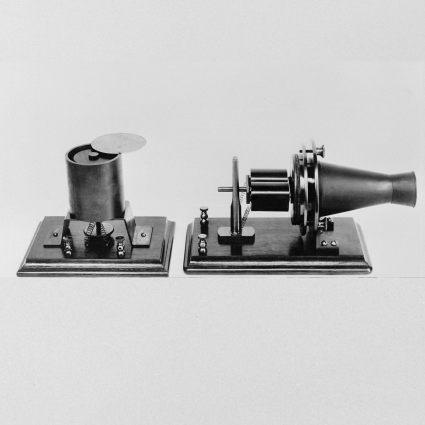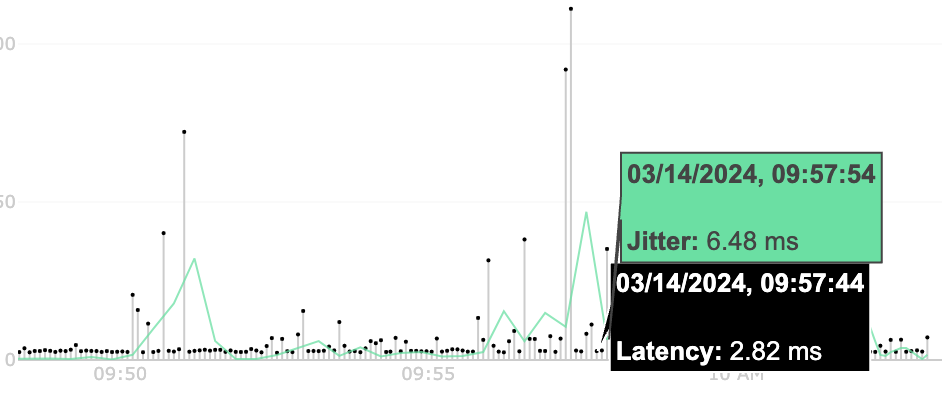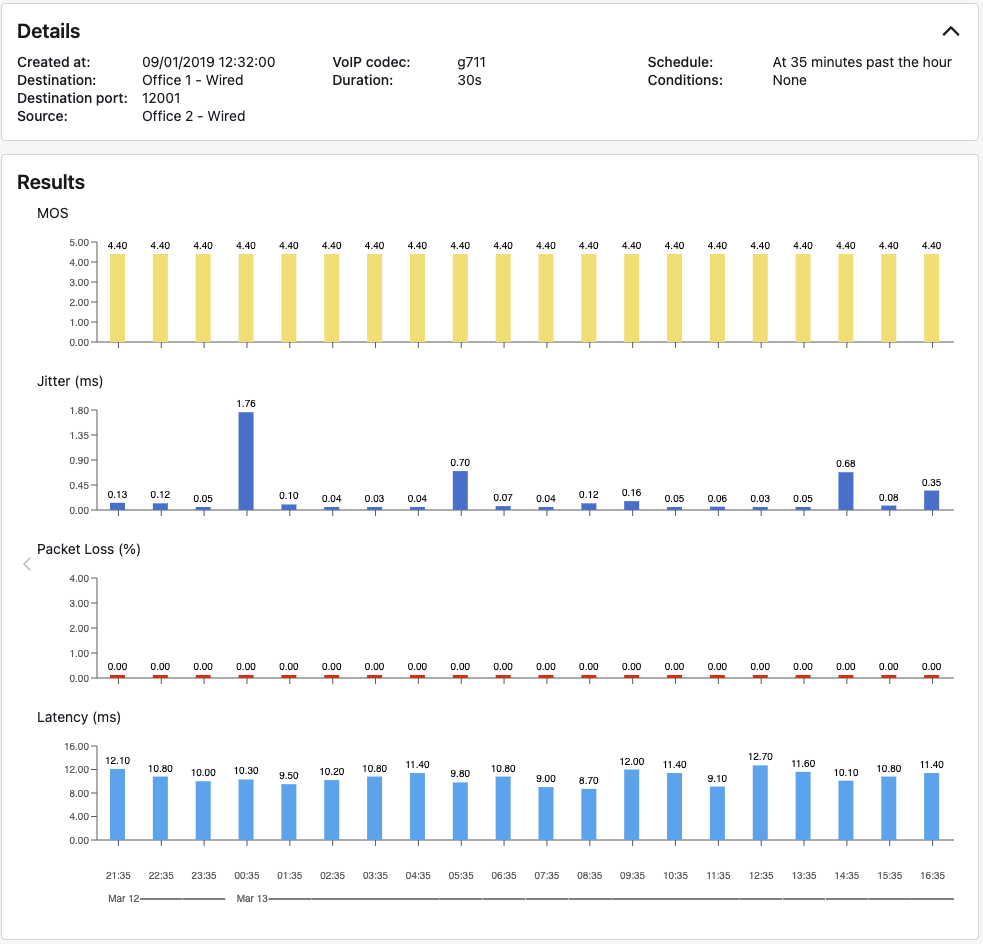Definition of VoIP
Voice-over-IP (VoIP), or digital telephony, is a communication technology that converts voice calls in digital format. This process enables voice calls to be transmitted across an IP network, such as the Internet. This technology is the evolution of analog telephony, emerged in 1876 when Alexander Graham Bell invented the telephone. Since its inception, the telephone has been an important part of our everyday lives and a critical function of doing business.

Today, telephony’s role and importance hasn’t diminished at all. The rapid deployment of VoIP technologies required the testing of the overall quality of VoIP systems. Here we will highlight key factors that engineers needs to consider when designing and operating a digital telephony infrastructure. We will talk about VoIP MOS (Mean Opinion Score), what it is, and how it is used to estimate the VoIP call quality.
The article is organized in the following sections:
- VoIP Architecture
- Understanding VoIP Performance Metrics
- Mean Opinion Score (MOS) Explained
- What Affects MOS Score
- Monitoring VoIP Performance
- Best Practices for Monitoring VoIP and MOS
Voice-over-IP and Plain Old Telephony Systems
Digital telephony offers many advantages over traditional Plain Old Telephony Systems (POTS). Most of all, by relying on internet packet switching technology, VoIP provides higher scalability, simpler infrastructure (less cables), advanced features for multi-party calls, and all the advantages of a software-based system. On the other end, as we will see in this article, VoIP requires proper planning, monitoring, and support processes to ensure that phone systems are always available, resilient, and well performing.
VoIP Architecture
In most common deployments, a VoIP architecture includes the following elements:
- VoIP Clients: They can be hardware phones, software-based phones or applications (softphones), or mobile devices. Users rely on VoIP clients to make and receive phone calls.
- VoIP Servers: Often known as IP PBXs (Private Branch Exchanges), these servers manage call routing, voicemail, and other telephony services.
- Voice Gateways: They act as bridges between a VoIP network and the Public Switched Telephone Network (PSTN), converting voice data from analog to digital formats and vice versa.
- Network Infrastructure: Composed by the routers, switches, and other networking equipment that enable the transmission of VoIP packets.
- Codec: A software or hardware component that compresses and decompresses voice signals for transmission over data networks.
- SIP Protocol: The Session Initiation Protocol (SIP) enables signaling and controlling multimedia communication sessions between VoIP systems.
The VoIP architecture relies on an IP network to transmit voice communication, leveraging internet protocols and broadband connections for telephony services.

VoIP Codecs
VoIP codecs are software or hardware functions developed for representing analog signals, such as human speech, into digital format. More specifically, when we speak into a VoIP phone, the codec first encodes an audio waveform into a digital bitstream. The phone then breaks down the digital bitstream into chunks of data so it can transmit the voice packets across an IP network. Subsequently, the phone on the receiver’s side processes the VoIP packets by decoding them into the original audio waveform. As you can imagine, this process must happen very quickly and with the minimal possible delay to ensure the integrity and clarity of voice communications.
At the moment, there are several different types of VoIP codecs (G.711, G.729, …), each with their own sampling technique, quality, bandwidth requirements, etc. Each voice codec affects the quality of the voice calls it encodes. During the design phase of a voice system, it’s important to select the codec that meets the business requirements.
VoIP Codecs Reference Table
The following table briefly summarizes key characteristics of the VoIP codecs implemented by NetBeez for testing and monitoring.
| Codec Name | Payload Size (Bytes) | Speech Payload (ms) | Packets per Second | Bit Rate (Kbps) |
| G.711 | 160 | 20 | 50 | 64 |
| G.729 | 20 | 20 | 50 | 8 |
| G.723.1-63 | 24 | 30 | 33.3 | 21.9 |
| G.723.1-53 | 20 | 30 | 33.3 | 20.8 |
| G.726 | 80 | 20 | 50 | 55.2 |
| G.728 | 60 | 30 | 33.3 | 31.5 |
| G.722 | 160 | 20 | 50 | 38.4 |
For each VoIP codec, the table reports:
- Payload size: The amount of voice data, expressed in bytes, that one single packet carriers.
- Speech payload: The speech duration, expressed in milliseconds, included within one voice packet.
- Packets per second: The number of packets transmitted per second. It’s possible to calculate the number of packets per second by dividing 1,000 by the speech payload.
- Bit rate: The data rate required to transmit one second of speech across the network. Calculate the bit rate by multiplying the payload size by the packets per second.
Understanding VoIP Performance Metrics
There are three key performance metrics that have an impact on VoIP calls: latency, jitter, and packet loss. When monitoring VoIP performance, it’s important to know what impacts these metrics, and what are acceptable values for each one of these metrics. In fact, these metrics directly influence the user experience, making it imperative for network administrators and service providers to optimize these parameters for seamless and reliable voice communication over the internet. Let’s review them all in detail.
Latency
Latency refers to the time that it takes for data packets to travel from the source to the destination, expressed in milliseconds (ms). This key performance indicator is one of the most critical factors in network performance analysis. There are various factors that impact latency, including the physical distance between the sender and receiver, the number of routers and switches the data packets have to traverse, and the processing time at each network node. As we’ll see in the next sections, the Quality of Service configuration on network equipment plays a crucial role in it. When latency is too high, conversations between two parties tend to lag, and participants tend to talk over each other because of this excessive lag introduced by the latency. A tool like One-Way Ping (OWAMP) can help identify latency issues across a link.
Jitter
Jitter is the variation of latency that causes a stream of packets sent at a regular interval to be received at an irregular interval at destination. This metric plays an important role especially for real-time applications such as voice and video calls. When the jitter value is higher than a specific value, it causes degradation of voice calls such as choppy conversations or metallic voice caused by the codec. Iperf is a TCP and UDP based throughput testing tool. When used in UDP mode, iperf will report the jitter detected between two endpoints.
In the following screenshot from a NetBeez VoIP MOS test, you can see the correlation between variation of latency (black lines) and jitter (green line chart).

Packet Loss
Packet loss is calculated as the percentage of packets that are corrupted or not received at all at destination. This key performance metric is a good measure of network quality that reflects its reliability to deliver packets to destination. Packet loss is caused by malformed packets being received by the destination, or worse, packets being dropped. It may happen that, along the way between the source and the destination, one or more intermediate routers discard packets due to congested queues. This occurs when routers are receiving more traffic that they can actually transmit (oversubscription). Packet loss cause conversations to sound as fragmented and distorted. There are different methods available to test for packet loss during the troubleshooting of VoIP degradation issues.
Importance of Jitter, Latency, and Packet Loss in MOS Scoring
Network performance metrics such as jitter, latency, and packet loss determine the quality of VoIP calls. Although acceptable values for these metrics vary based on the VoIP codec used, generally they all need to fall within certain ranges to ensure a good VoIP audio quality.
- Latency: To achieve high MOS scores, latency values should be below 150 milliseconds (ms) for one-way communication (one person speaking and the other listening). A round-trip latency (total time for a signal to travel from the sender to the receiver and back) of 150 ms or lower is generally acceptable for VoIP calls. Higher latencies can cause noticeable delays and affect the conversational flow.
- Jitter: To achieve high MOS scores, jitter should be kept below 30 ms. Jitter within this range ensures that the variation in packet arrival times is minimal, leading to smooth voice playback. VoIP systems often use jitter buffers to mitigate the effects of jitter, but excessive jitter can still result in audio disruptions if not properly managed.
- Packet Loss: To achieve high MOS scores, packet loss should be 3% or lower. This means that only 3 out of 100 packets are lost during transmission. Packet loss can cause voice distortion, choppiness, or gaps in the conversation. VoIP protocols, such as Real-time Transport Protocol (RTP), include mechanisms to handle lost packets, but minimizing packet loss is crucial for optimal call quality.
Network administrators should monitor these parameters regularly and take appropriate measures to get high MOS scores. Measures include Quality of Service (QoS) configurations, bandwidth management, and network optimizations. These precautions will help achieve higher MOS score and voice quality in VoIP communications.
NetBeez VoIP Monitoring
NetBeez offers an easy solution for monitoring VoIP MOS, whether the service is managed in house or by a VoIP service provider such as RingCentral or Five9. If you want to learn more about it, request a product tour.
Mean Opinion Score (MOS) Explained
The Mean Opinion Score (MOS) is a quality indicator for analog and digital voice and video communications, as well as audiovisual systems. MOS is an easy to understand rating that ranges from a bad experience with a value of 1 to an excellent one with a value of 5. Network and voice engineers use this score to evaluate, monitor, and improve the end-user experience of a digital telephony infrastructure.
How to Calculate MOS
There are two main ways to calculate MOS values: subjective and objective. The ITU-T P.800 recommendation describes a “subjective” method for MOS calculation. In this implementation, a group of users individually judge the quality of speech by simply listening, in a quiet room, to a voice call. Each listener would then express an opinion with a score from 1 (poor quality) to 5 (excellent quality). The average of their score represents the overall listening quality for the transmission system under evaluation. The following table summarizes the MOS scale and its significance in assessing voice quality.
| MOS Scale | Quality | Call Satisfaction |
| 5 | Excellent | Very satisfied |
| 4 | Good | Satisfied |
| 3 | Fair | Some users dissatisfied |
| 2 | Poor | Many users dissatisfied |
| 1 | Bad | Nearly all users dissatisfied |
MOS Scores in VoIP
In digital communications, it’s preferred to use an objective method that for MOS scoring. Objective methods to measure MOS scores easily scale, and can run continuously through network testing. The ITU-T G.107 is a standard that provides specifics for the implementation of the E-model algorithm for MOS calculation. The E-model algorithm relies on a “rating factor” R that converts into an objective MOS score to estimate the user’s opinion. The following table summarizes the corresponding MOS value, given an R factor. As you can see, the user satisfaction and MOS scores are slightly different from the subjective ratings.
| R factor | MOS Scale | User satisfaction |
| 90+ | 4.34+ | Very satisfied |
| 80+ | 4.03+ | Satisfied |
| 70+ | 3.60+ | Some users dissatisfied |
| 60+ | 3.10+ | Many users dissatisfied |
| 50+ | 2.58+ | Nearly all users dissatisfied |
What Affects MOS Score
There are three main factors that prevent having a high MOS score in VoIP communications:
- VoIP codec used
- Network performance
- End-user equipment (phones)
In the following sections, we’ll briefly review the first two items given the relevance to this blog. For the end-user equipment, we recommend working with your supplier to identify the best option given the requirements.
MOS Scoring and VoIP Codecs
Each VoIP codec implements a specific sampling technique that defines the quality of the voice and corresponding MOS. The ITU-T G.107 standard assigns a nominal MOS value to each codec assuming ideal conditions of packet loss, latency, and jitter throughout the duration of the call. The following table summarizes the nominal MOS scores for some of the most commonly used VoIP codecs.
| Codec Name | Bit Rate (Kbps) | Coding Method | MOS Nominal |
| G.711 | 64 | PCMA | 4.40 |
| G.729 | 8 | LD-CELP | 3.92 |
| G.723.1-63 | 21.9 | MP-MLQ | 3.95 |
| G.723.1-53 | 20.8 | ACELP | 3.78 |
| G.726 | 55.2 | ADPCM | 3.85 |
| G.728 | 31.5 | LD-CELP | 3.61 |
| G.722 | 38.4 | SB-ADPCM | 4.5 |
The two main takeaway from the above table is that:
- Some codecs will achieve higher MOS scores than others
- Codes with high MOS score generally require more bandwidth than those with low MOS score
MOS and Network Performance Monitoring
Network performance metrics such as latency, packet loss, and jitter, have a direct impact on the MOS score. This can be verified using an objective measure such as the E-model R factor. By providing as input the real-time latency, packet loss, and jitter value, it’s possible to see how MOS varies based on network conditions. This is the basic principle for implementing real-time monitoring and alerting in a VoIP environment.
In the end, to have a high MOS score you want to have low latency (<100 ms) and jitter (<20 ms), and no packet loss.
Common Causes for Poor MOS Score
Here are some situations that prevent achieving high MOS scores:
- Bandwidth limitations – Under-provisioned circuits limit the quality of the VoIP calls going across. Since each codec has a specific bitrate, engineers should ensure that the network can handle the planned call volume.
- Network congestion – Even when circuits are correctly provisioned for capacity, network congestion could occur, causing voice packets to be dropped. Without a Quality of Service (QoS), all network traffic (voice and data) is treated in the same way. This can lead to VoIP degradation.
- QoS configurations – QoS is a network configuration setting that gets applied to any network device that VoIP traffic traverses. Typically, IP traffic marked with the Expedited Forwarding (EF) class. Misconfiguration of QoS, including incorrect traffic marking, queuing, and prioritization, can cause improper handling of VoIP traffic.
Monitoring VoIP Performance
Monitoring VoIP performance and availability offers several key benefits that are essential for maintaining high-quality voice communication over IP networks. First of all, it ensures consistent call quality by monitoring metrics like jitter, latency, and packet loss. By identifying and addressing these issues proactively, VoIP monitoring helps in reducing call drops and improving overall user experience.
Second, it aids in bandwidth management, allowing network administrators to optimize network resources and prevent congestion, which is vital for maintaining the clarity of voice calls. Additionally, VoIP monitoring provides valuable insights into network performance, enabling timely identification and resolution of network-related issues before they escalate into major disruptions. This proactive approach not only enhances the reliability of VoIP services but also supports better service level agreement (SLA) adherence, contributing to higher customer satisfaction and trust.
Introduction to VoIP Monitoring Tools
When selecting a VoIP monitoring tool, several critical factors based on organizational requirements and usage scenarios must be considered to ensure optimal performance and service quality.
Firstly, the location of the VoIP servers, whether on-premises or in the cloud, plays a significant role in tool selection. For on-premises servers, a solution that supports both cloud-based and on-premises deployments might be necessary, especially if there’s a mix of in-office and remote users. In contrast, a cloud-only solution may suffice for entirely cloud-hosted VoIP services. This choice is also influenced by the network topology of the organization and the distribution of end-users. For instance, if a significant number of users work remotely, a monitoring solution focused on active monitoring would be more beneficial, as it can more effectively manage and troubleshoot issues that arise in varied network environments outside the corporate infrastructure.
Secondly, it’s crucial to understand the nature of the VoIP service. If the service is used for internal communication only, the monitoring requirements might be less stringent compared to when it’s used for customer-facing roles, like in contact centers. Customer-facing services demand high MOS scores, as any compromise in service quality can negatively impact the company’s reputation and customer satisfaction. In such scenarios, installing software agents on each end-user’s device might be necessary, especially for remote contact center agents. This approach allows for more granular monitoring and faster issue resolution, which is vital for maintaining the high service standards expected in customer interactions. On the other hand, for internal use or on-premises contact centers, relying on existing network monitoring capabilities of the organization might be adequate.
Active and Passive Monitoring Approaches
Active and passive monitoring represent two fundamental approaches in VoIP monitoring, each serving unique and vital roles.
Active network monitoring is defined by its real-time testing of network infrastructure and applications. This is achieved through software agents or hardware sensors that assess network availability and performance. Such monitoring actively reports data like end-to-end reachability, latency, packet loss, jitter, and bandwidth. A key advantage of active monitoring is its ability to provide instant feedback on the network and application performance.
On the other hand, passive network monitoring involves the analysis and capture of actual user data or traffic flow. This approach focuses on generating aggregate traffic statistics, breaking them down by protocols and hosts. It enables network administrators to identify heavy traffic sources and diagnose performance issues between clients and servers. Passive monitoring is commonly implemented through methods such as Network TAPs, SPAN ports, and flow-based protocols. This method does not actively test the network. However, it provides valuable insights into the network’s usage and behavior by observing existing traffic.
Best Practices for Monitoring VoIP and MOS
NetBeez provides a simple and effective way to monitor VoIP and MOS performance at scale. As an active network monitoring solution, NetBeez offers easy-to-deploy network monitoring solution that matched the needs of remote work organizations. In few steps, it’s possible to configure VoIP monitoring at remote branch offices, data centers, headquarters, and remote workers. You can start a free trial.

Step1: Deploy network agents in private and public networks
The Network Agents are hardware and software appliances that monitor network conditions, service availability, and MOS VoIP. Monitoring is performed from private and public networks. Private networks include branch offices, headquarters, and data centers. Public networks are cloud providers such as AWS, Azure, and Google.
Organizations that use a cloud VoIP service provider, should deploy three or more cloud agents. These agents verify that the VoIP service is available and well performing.
Step 2: Install remote worker agents to end-users
The Remote Workers Agents (RWA) verify VoIP service’s availability and performance from the perspective of the end-user. These lightweight software clients are compatible with operating systems such as Windows, Mac OS, or iGel. RWAs provide comprehensive MOS VoIP data, including performance of the user device, home LAN, and internet service provider network. This method is particularly effective for quickly pinpointing the root cause of VoIP issues encountered by remote users. We recommend the installation of Remote Worker Agents for agents that work in remote contact centers. By analyzing data from both network agents and remote worker agents, IT teams gain a thorough understanding of VoIP performance.
Step 3: Configure VoIP monitoring targets and tests
NetBeez supports different options for monitoring VoIP performance. Via the user dashboard, the IT staff configures a VoIP MOS test to the following resources:
- Targets to the most common cloud-based VoIP providers (e.g. Five9, RingCentral, …)
- Custom targets to on-premises VoIP servers (e.g. Avaya, Cisco, …)
- Scheduled VoIP tests simulating G.711, G.729, … codecs
Once the tests are applied to the agents, NetBeez starts collecting real-time performance data from these remote units. The central server does the MOS calculation, alerting if the MOS values drop below a certain threshold. The data available on the dashboard provides immediate insights and proactive alerts into VoIP and MOS performance.
The following screenshot displays the MOS values of a VoIP test using the G.711 codec.

Case Study: VoIP Performance of Remote Contact Center Agents
A Fortune 500 insurance company tackled significant VoIP quality issues faced by its home-based contact center agents. In this industry, an excellent audio quality is crucial for maintaining 5-star customer experience. With the pandemic-induced shift to remote work, agents using consumer-grade internet connections experienced degraded call quality. This led to increased IT help desk calls. Most of these calls complained about choppy voice calls and other audio quality issues.
The company utilized NetBeez’s monitoring tool to diagnose and address these VoIP call quality issues. NetBeez provided mean opinion scores and network performance monitoring data necessary to pinpoint the root causes of audio problems. The help desk now quickly identifies audio quality issues originating within the internet service provider network. This approach helped contact center agents retaining high MOS scores, improving call quality and customer service.
Conclusion on VoIP and MOS
In conclusion, ensuring optimal MOS scores is paramount for any VoIP service provider and user to maintain high-quality communication experiences. Through diligent network performance monitoring and adherence to MOS scoring standards, the help desk can proactively address potential issues and uphold satisfactory call quality.





